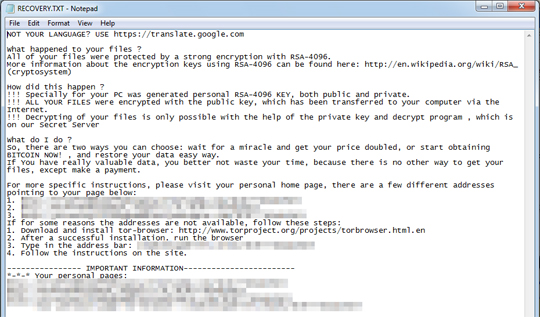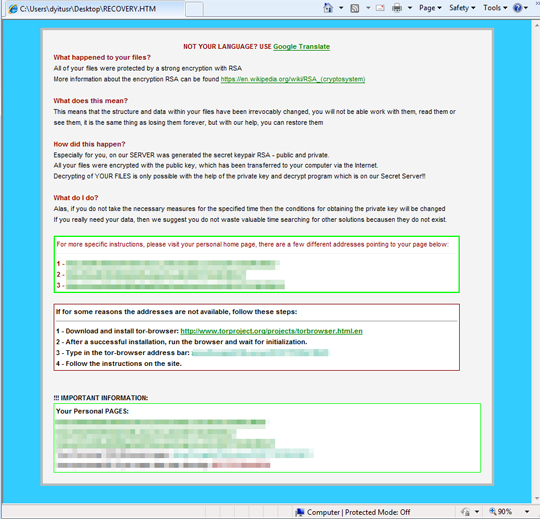RANSOM_CRYPTESLA.ABX
Ransom:Win32/Tescrypt (Microsoft), Win32/Filecoder.TeslaCrypt.I (ESET-NOD32)
Windows


Threat Type: Trojan
Destructiveness: No
Encrypted:
In the wild: Yes
OVERVIEW
Downloaded from the Internet, Dropped by other malware
This Trojan arrives on a system as a file dropped by other malware or as a file downloaded unknowingly by users when visiting malicious sites.
It modifies the Internet Explorer Zone Settings.
It connects to certain websites to send and receive information.
TECHNICAL DETAILS
360,448 bytes
EXE
Yes
08 Mar 2016
Corrupts hard disk, Encrypts files, Terminates processes, Connects to URLs/IPs
Arrival Details
This Trojan arrives on a system as a file dropped by other malware or as a file downloaded unknowingly by users when visiting malicious sites.
Installation
This Trojan drops the following copies of itself into the affected system and executes them:
- %Windows%\{random filename}.exe (with Administrator Privileges)
- %My Documents%\{random filename}.exe (with non-Administrator Privileges)
(Note: %My Documents% is C:\Users\{user name}\Documents on Windows Vista and above.)
(Note: %Windows% is the Windows folder, where it usually is C:\Windows on all Windows operating system versions.)
It drops the following file(s)/component(s):
- %Desktop%\RECOVERY.HTM
- %Desktop%\RECOVERY.png
- %Desktop%\RECOVERY.TXT
- %User Profile%\Recovery+{random characters}.html
- %User Profile%\Recovery+{random characters}.png
- %User Profile%\Recovery+{random characters}.txt
- {Folders containing encrypted files}\Recovery+{random characters}.html
- {Folders containing encrypted files}\Recovery+{random characters}.png
- {Folders containing encrypted files}\Recovery+{random characters}.txt
- %My Documents%\recover_file_{random characters}.txt
- %My Documents%\{random filename 2}.exe - detected as TROJ_DESHACOP.C. This component is used to delete shadow copies by executing the following command:
vssadmin.exe delete shadows /all /Quiet
(Note: %My Documents% is usually C:\Documents and Settings\{user name}\My Documents on Windows 2000, XP, and Server 2003, or C:\Users\{user name}\Documents on Windows Vista and 7.)
(Note: %Desktop% is the desktop folder, where it usually is C:\Documents and Settings\{user name}\Desktop in Windows 2000, Windows Server 2003, and Windows XP (32- and 64-bit); C:\Users\{user name}\Desktop in Windows Vista (32- and 64-bit), Windows 7 (32- and 64-bit), Windows 8 (32- and 64-bit), Windows 8.1 (32- and 64-bit), Windows Server 2008, and Windows Server 2012.. %User Profile% is the current user's profile folder, which is usually C:\Documents and Settings\{user name} on Windows 2000, XP, and Server 2003, or C:\Users\{user name} on Windows Vista and 7.)
Autostart Technique
This Trojan creates the following registry entries to enable automatic execution of dropped component at every system startup:
HKEY_CURRENT_USER\Software\Microsoft\
Windows\CurrentVersion\Run
{4 random characters}-{8 random characters} = "%Windows%\{random filename}.exe" (with Administrator Privileges)
HKEY_CURRENT_USER\Software\Microsoft\
Windows\CurrentVersion\Run
{4 random characters}-{8 random characters} = "%My Documents%\{random filename}.exe" (with non-Administrator Privileges)
Other System Modifications
This Trojan adds the following registry keys:
HKEY_CURRENT_USER\Software\xxxsys
HKEY_CURRENT_USER\Software\{Installation ID}
It adds the following registry entries as part of its installation routine:
HKEY_CURRENT_USER\Software\xxxsys
ID = {Installation ID}
Web Browser Home Page and Search Page Modification
This Trojan modifies the Internet Explorer Zone Settings.
Other Details
This Trojan connects to the following website to send and receive information:
- http://{BLOCKED}i.se/wp-admin/user/bstr.php
- http://{BLOCKED}bain.com/legacy/language/bstr.php
- http://{BLOCKED}rkicks.com/wp-includes/images/bstr.php
- http://{BLOCKED}angym.com/bstr.php
- http://infotlogomas.{BLOCKED}kota.go.id/admin/style/bstr.php
- http://csucanuevo.{BLOCKED}a.org/attachments/wp-content/bstr.php
It encrypts files with the following extensions:
- .3fr
- .7z
- .accdb
- .ai
- .amp
- .apk
- .arch00
- .arw
- .asset
- .avi
- .bar
- .bay
- .bc6
- .bc7
- .big
- .bik
- .bkf
- .bkp
- .blob
- .bsa
- .cas
- .cdr
- .cer
- .cfr
- .cr2
- .crt
- .crw
- .css
- .csv
- .d3dbsp
- .das
- .dazip
- .db0
- .dba
- .dbf
- .dcr
- .der
- .desc
- .dmp
- .dng
- .doc
- .docm
- .docx
- .dwg
- .dxg
- .epk
- .eps
- .erf
- .esm
- .ff
- .flv
- .forge
- .fos
- .fpk
- .fsh
- .gdb
- .gho
- .hkdb
- .hkx
- .hplg
- .hvpl
- .ibank
- .icxs
- .indd
- .itd
- .itdb
- .itl
- .itm
- .iwd
- .iwi
- .jpeg
- .jpg
- .js
- .kdb
- .kdc
- .kf
- .layout
- .lbf
- .litemod
- .lrf
- .ltx
- .lvl
- .m2
- .m3u
- .m4a
- .mcmeta
- .mdb
- .mdbackup
- .mdd
- .mddata
- .mdf
- .mef
- .menu
- .mlx
- .mov
- .mp4
- .mpqge
- .mrwref
- .ncf
- .nrw
- .ntl
- .odb
- .odc
- .odm
- .odp
- .ods
- .odt
- .orf
- .p12
- .p7b
- .p7c
- .pak
- .pdd
- .pef
- .pem
- .pfx
- .pkb
- .pkpass
- .png
- .ppt
- .pptm
- .pptx
- .psd
- .psk
- .pst
- .ptx
- .py
- .qdf
- .qic
- .r3d
- .raf
- .rar
- .raw
- .rb
- .re4
- .rgss3a
- .rim
- .rofl
- .rtf
- .rw2
- .rwl
- .sav
- .sb
- .sid
- .sidd
- .sidn
- .sie
- .sis
- .slm
- .snx
- .sql
- .sr2
- .srf
- .srw
- .sum
- .svg
- .syncdb
- .t12
- .t13
- .tax
- .tor
- .txt
- .upk
- .vcf
- .vdf
- .vfs
- .vfs0
- .vpk
- .vpp_pc
- .vtf
- .w3x
- .wallet
- .wb2
- .wma
- .wmo
- .wmv
- .wotreplay
- .wpd
- .wps
- .x3f
- .xf
- .xlk
- .xls
- .xlsb
- .xlsm
- .xlsx
- .xxx
- .zip
- .ztm
- .ztmp
NOTES:
This malware appends the extension .mp3 to the encrypted files.
It terminates processes containing the following strings:
- askmg
- rocex
- egedi
- sconfi
- cmd
It avoids encrypting files found in the following folder:
- Windows
- Program Files
- %All Users Profile%\Application Data - if infected system is running Windows XP or older
- ProgramData - if infected system is running Windows Vista or newer
It opens the dropped ransom notes:



It encrypts files in all fixed, removable, and network drives and shares.
SOLUTION
9.800
12.364.08
25 Feb 2016
12.365.08
26 Feb 2016
Step 1
Before doing any scans, Windows XP, Windows Vista, and Windows 7 users must disable System Restore to allow full scanning of their computers.
Step 2
Scan your computer with your Trend Micro product and note files detected as RANSOM_CRYPTESLA.ABX
Step 3
Restart in Safe Mode
Step 4
Delete this registry value
Important: Editing the Windows Registry incorrectly can lead to irreversible system malfunction. Please do this step only if you know how or you can ask assistance from your system administrator. Else, check this Microsoft article first before modifying your computer's registry.
- In HKEY_CURRENT_USER\Software\Microsoft\Windows\CurrentVersion\Run
- {4 random characters}-{8 random characters} = "%Windows%\{random filename}.exe" <i>(For Windows XP and below)</i>
- {4 random characters}-{8 random characters} = "%Windows%\{random filename}.exe" <i>(For Windows XP and below)</i>
- In HKEY_CURRENT_USER\Software\Microsoft\Windows\CurrentVersion\Run
- {4 random characters}-{8 random characters} = "%My Documents%\{random filename}.exe" <i>(For Windows Vista and above)</i>
- {4 random characters}-{8 random characters} = "%My Documents%\{random filename}.exe" <i>(For Windows Vista and above)</i>
- In HKEY_CURRENT_USER\Software\xxxsys
- ID = {Installation ID}
- ID = {Installation ID}
Step 5
Delete this registry key
Important: Editing the Windows Registry incorrectly can lead to irreversible system malfunction. Please do this step only if you know how or you can ask assistance from your system administrator. Else, check this Microsoft article first before modifying your computer's registry.
- In HKEY_CURRENT_USER\Software
- xxxsys
- xxxsys
- In HKEY_CURRENT_USER\Software
- {Installation ID}
- {Installation ID}
Step 6
Search and delete these files
- %Desktop%\RECOVERY.HTM
- %Desktop%\RECOVERY.png
- %Desktop%\RECOVERY.TXT
- Recovery+{random characters}.html
- Recovery+{random characters}.png
- Recovery+{random characters}.txt
- %My Documents%\recover_file_{random characters}.txt
- %My Documents%\{random filename 2}.exe
Step 7
Restart in normal mode and scan your computer with your Trend Micro product for files detected as RANSOM_CRYPTESLA.ABX. If the detected files have already been cleaned, deleted, or quarantined by your Trend Micro product, no further step is required. You may opt to simply delete the quarantined files. Please check this Knowledge Base page for more information.
Step 8
Restore encrypted files from backup.
Did this description help? Tell us how we did.

